Pyramid Valley Wine From New Zealand: Terroir Taken To The Extreme
by Ken Gargett
Around a dozen years ago, during a trip to New Zealand – possibly for a rugby game, trout fishing, or the wineries (the memories of some of these trips merge) – I had one of those days. I got to visit not one but two wineries on my bucket list.
In truth, I had been to the extraordinary Bell Hill vineyard before, but it was my first visit to cult favorite Pyramid Valley (while this piece may focus on the wonders of Pyramid Valley, I am at least as equally enamored of the wines of Bell Hill).
Both of these tiny operations are in the Waipara region, North Canterbury, in the southern part of South Island.
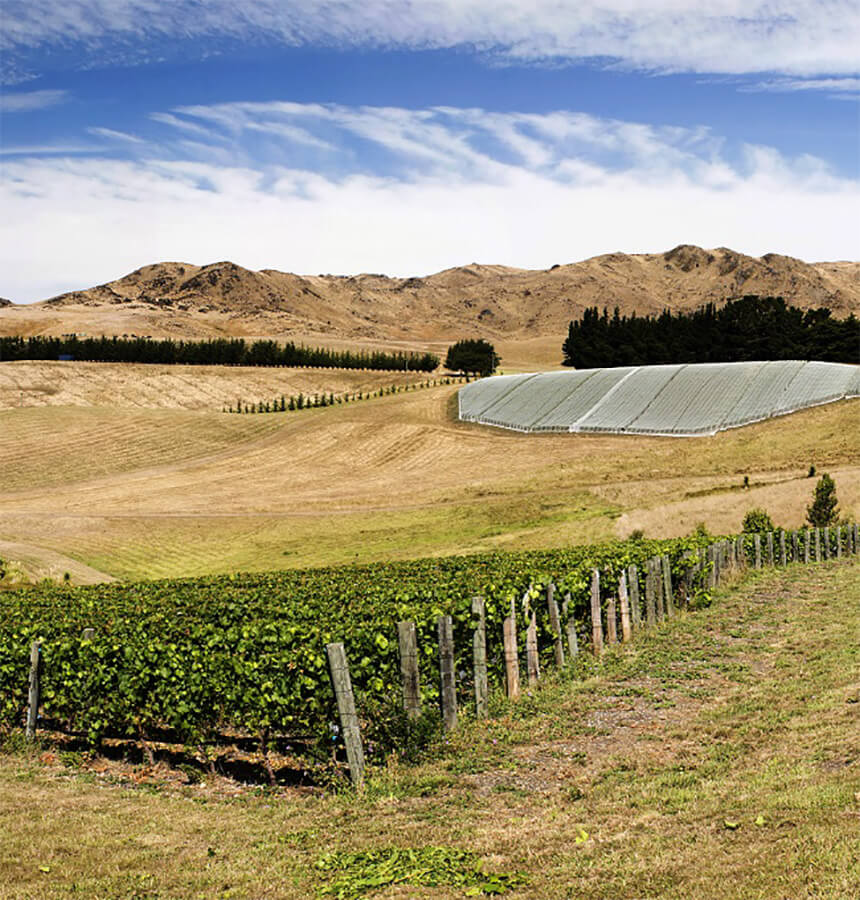
Pyramid Valley Lion’s Tooth to Angel Flower vineyards in New Zealand
At the time it was not that easy to visit Pyramid Valley, or at least that is what my dodgy memory is telling me. But I vividly remember my first impression.
Mike and Claudia Weersing, the founders of Pyramid Valley, could not have been more welcoming. And there, on a ledge, was a jar of rather rare Cohiba cigars (I forget which). Turns out that Mike, originally from California (Claudia is originally from Germany but grew up in America), was a fan and we spent some time yacking about cigars, Cuba, and the usual cabbages and kings before we remembered that I was actually there to talk about their wines.
History of Pyramid Valley wine
Mike and Claudia Weersing established Pyramid Valley around 2000, but it was in the works for many years before that.
Mike had an art history background but in the early 1990s traveled to Burgundy – the “seeds of inspiration,” I believe he called it. Mike worked in Europe until the late 1990s at some impressive wineries – Pousse d’Or, de Montille, Potel, Deiss, and Loosen – but also did vintages in Oregon, with James Halliday at Coldstream Hills in Australia’s Yarra Valley, and at Neudorf in the Nelson region in the very north of New Zealand’s South Island, one of the world’s great brown trout regions. While in Europe, Mike lived in an old Volkswagen van while he worked and studied.
By late last century, the Weersings had begun the search for the best possible site to grow Pinot Noir and, to a lesser extent, Chardonnay. They searched from one end of New Zealand to the other as well as other countries.
Clay/limestone was the key. The former providing volume, body, and flesh; the latter backbone, structure, and vigor. Soil is obviously a crucial element of fine wine, but in truth I usually think that your typical wine lover has about as much interest in it as I have in knowing where the components to the computer I am tapping on came from. In other words: none at all.
Yet I have never had, before or since, such an in-depth discussion on the pros and cons of various soil types as I had with Mike that day. I still have pages of notes from that discussion, which ranged around the globe to different soils and their impact on different varieties – fascinating to me, but I will spare you. Suffice it to say, if you want to learn about soils and their impact on wines, go find Mike.
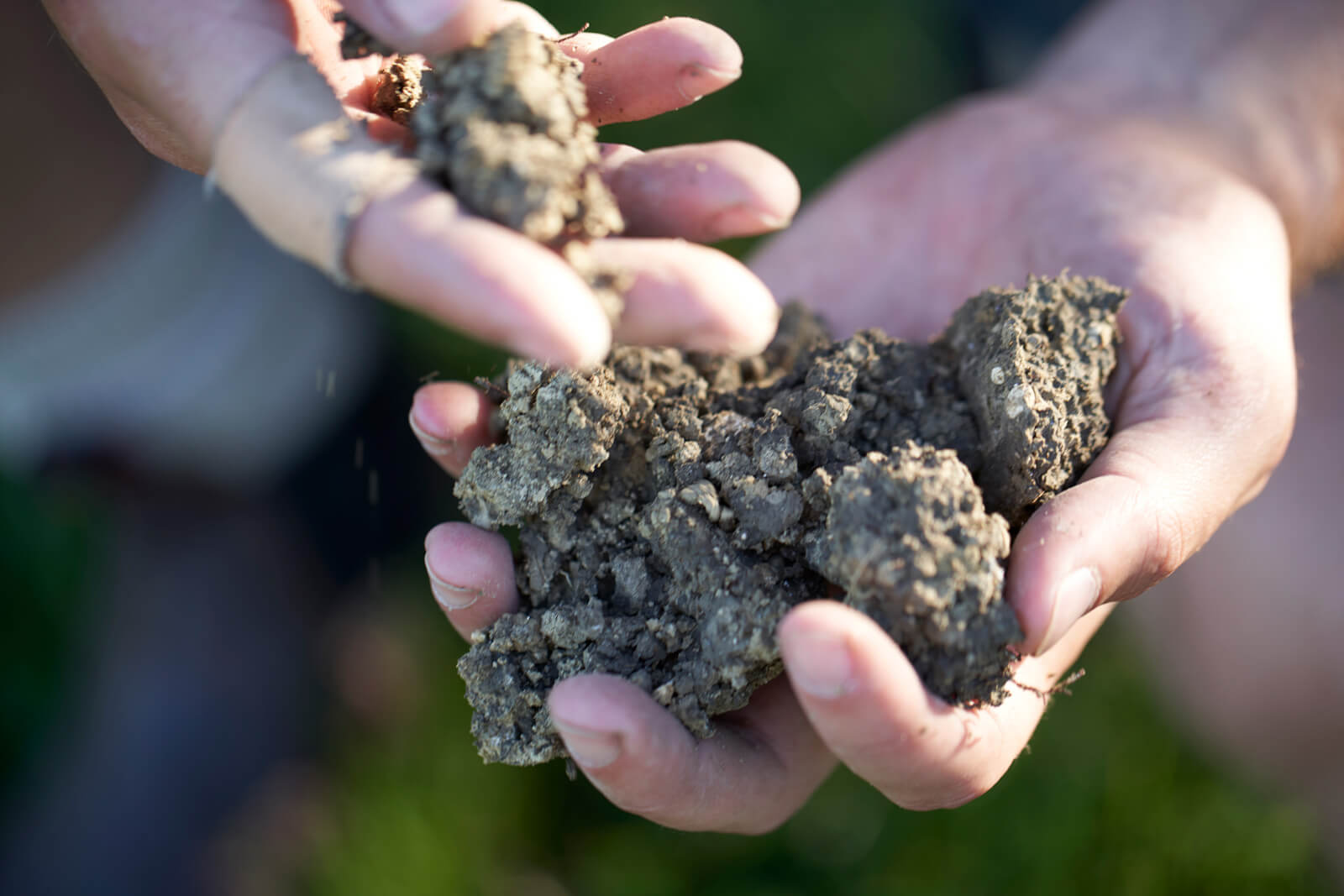
Pyramid Valley wines begin with the earth
One other thing about soil geeks: they dig holes. Every chance they get, they’ll dig a hole. Hundreds of them. And the samples get sent off to laboratories on the other side of the planet for analysis and assessment. Mike looked for three years in New Zealand and 15 overall – he mentioned Europe, California, New Mexico, Portugal (not sure why it got separated from the rest of Europe but no matter), and all over Australia.
Mike spoke of liquifying the geography into wine. He has also been quoted elsewhere, saying that he knew he was “anal” about the search but he also knew he was “old enough and poor enough” that he really only had one shot at it and he was determined to get it right. For him, the grape is merely the messenger, “not the voice.”
I understand he was about to give up and head to Uruguay when the results came back from the final holes and he had what he was looking for. If I recall, it was only yards from the very first hole he’d dug, which had given a completely different result. It does show how much the soil/terroir can vary in an extremely short distance. The place was an old sheep farm in Waikari, North Canterbury.
Mike undertook various trials before close planting his tiny vineyards, but the Weersings have also used grapes from local growers. He is very much a supporter of biodynamics, believing from his experience in Europe that it produces the healthiest vineyards. He also uses wild yeasts in accord with that philosophy. Claudia was more skeptical of biodynamics but soon came around.
The aim was to eventually make around 1,500 cases from the estate fruit.
The Pyramid Valley approach
Mike’s approach will be familiar to lovers of Burgundy and, indeed, anyone who focuses on terroir rather than merely the taste of grapes.
Tasting notes from that visit are hardly relevant today, but my favorite at the time was a Pinot Noir from the Calvert Vineyard in Central Otago. I remember a subsequent occasion when fruit sourced from this vineyard was split among three makers and we had the chance to see the influence of those three winemakers on the same fruit – they were Mike from Pyramid Valley, Blair Walter from Felton Road, and Steve Smith from Craggy Range. It was an indicator of what was to come.
As mentioned, the estate is small, just 2.2 hectares, and planted only with Pinot Noir and Chardonnay, though other wines are made from growers’ fruit, sourced elsewhere. The estate has four discrete sites. The sites on the property are not neat squares or anything like it. From the perspective of a drone they follow the soil and look almost like abstract art.
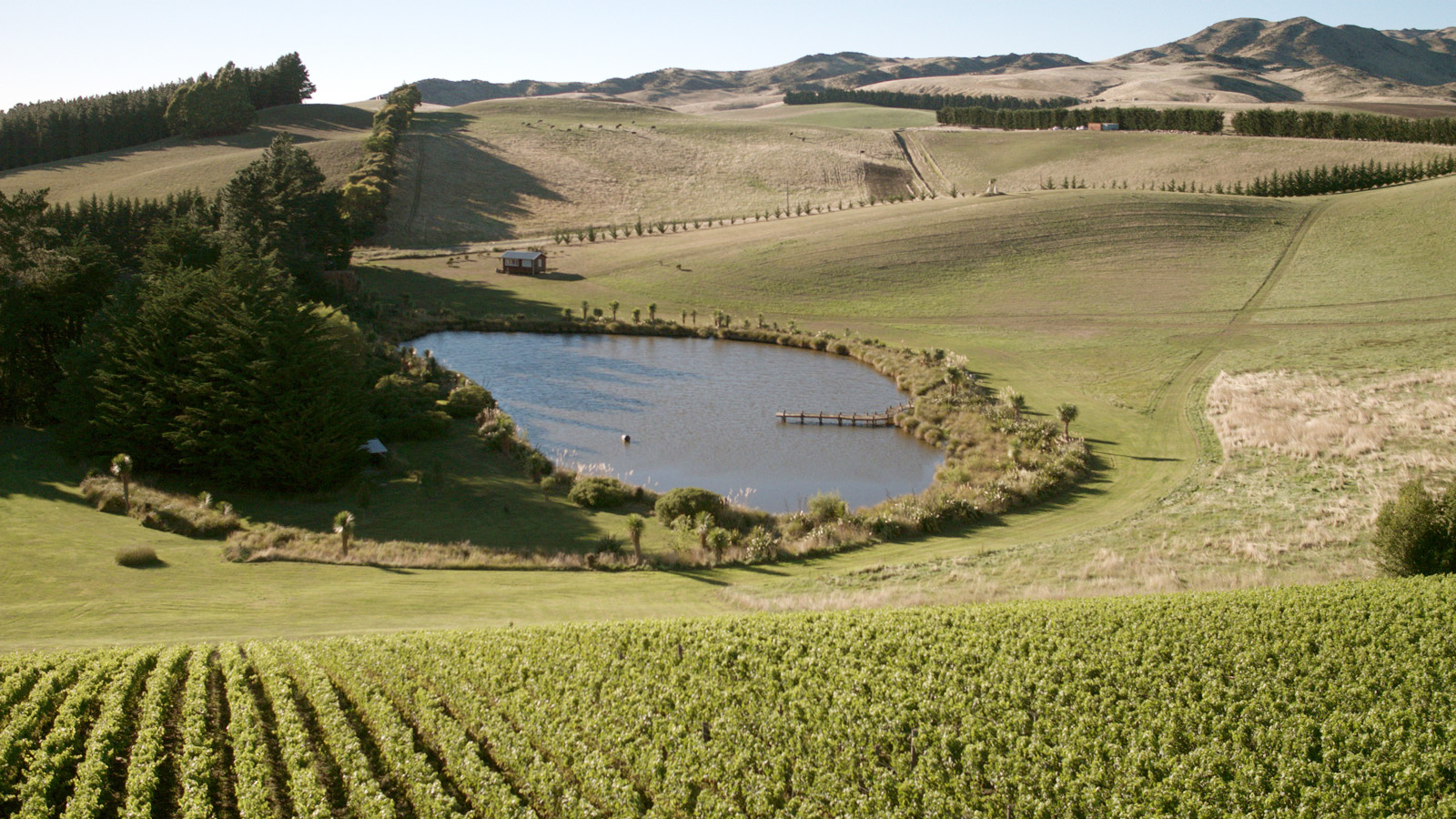
Pyramid Valley Lake and Lion’s Tooth vineyards
The four sites comprise the Earth Smoke and Angel Flower vineyards, both planted with Pinot Noir, and the Lion’s Tooth and Field of Fire vineyards, planted with Chardonnay. Terrific names when you first hear them but they come from a rather prosaic source – the weeds that grow between the rows. It could have been worse. The weed known as field of fire is also called “quack.” Angel flower is also called yarrow, and lion’s tooth is another name for dandelion.
I mentioned an indicator of things to come. Steve Smith was one of the founders of Craggy Range but left a few years ago to establish a small wine empire with his friend from the States, squillionaire businessman Brian Sheth (we looked at the Smith & Sheth wines in Smith & Sheth Cru: Rich, Exciting Wines From New Zealand With Alluring Aromas).
In 2017, Smith and Sheth purchased Pyramid Valley for NZ$8 million (who knows, perhaps in the years to come they might make a takeover offer for Craggy Range itself). They also brought the Lowburn Ferry Estate in Central Otago into the fold (more below).
If anyone knows these wines well enough to continue the legacy of Mike and Claudia, it is surely Steve Smith. In 2018, the new operation expanded to include the Manata Estate at Lowburn, as mentioned, making the duo’s holdings a two-estate property. The original estate will be named Waikiri Estate (if this means that they will eventually drop the name Pyramid Valley I think that would be a little strange – it has developed an international cult following for stunning wines, so I am not sure why they would want to lose that), while Lowburn Ferry is to become Manata Estate.
As the tasting notes below will show, Pyramid Valley has two “levels.” The Botanical Collection consists of the four discrete sites, while what was the Growers Collection will now be called the Appellation Collection.
The Botanical Collection will eventually include the Snakes Tongue Central Otago Pinot Noir from the Manata Estate. It is worth mentioning that these are early days for the two guys with these vineyards and so it would not be unreasonable to expect changes to the plans over time.
Pyramid Valley tasting notes
Pyramid Valley North Canterbury Sauvignon + 2019: Should one judge subjectively or objectively? A little of both? Sauvignon Blanc is a divisive variety at the best of times, but this wine takes it to a new level. You will love it or hate it; I don’t see many sitting on the fence.
The extreme-worked Kiwi Sauvs come in the form of Dog Point Section 94, which I really like, or the Cloudy Bay To Koko, not so much. For me, this falls in with the latter category. As they say in the classics, not my cup of tea at all. But there will be many who adore it.
The team has thrown everything it can at this wine. A dollop of Riesling, portions left on skins and fermented in amphora, other parcels in barrel with wild yeasts and some in stainless steel. It sat on ferment lees with no SO2 for three months before blending and was bottled unfined. All of this is why the wine is labeled with the “+.” From three vineyards in the Waipara region.
A pungent wine with herbals, a hint of creaminess, and a real soursop note. A wine with power, force, and length. It is building complexity and should be interesting in three to four years. The flavors might not appeal to me, but they will to many and it is undoubtedly a well-crafted and interesting wine. And in the world of worked Savvy’s, value. 90. AUD$30.
Pyramid Valley North Canterbury Chardonnay 2018: A cracking Chardonnay. For AUD$50, this is stunning value. A mix of Clone 5 and Mendoza from the Three Sisters vineyard in Waipara, which was planted between 2001 and 2004. Wild fermented, 12 months in French barrels, 20 percent new. Bottled unfiltered and unfined.
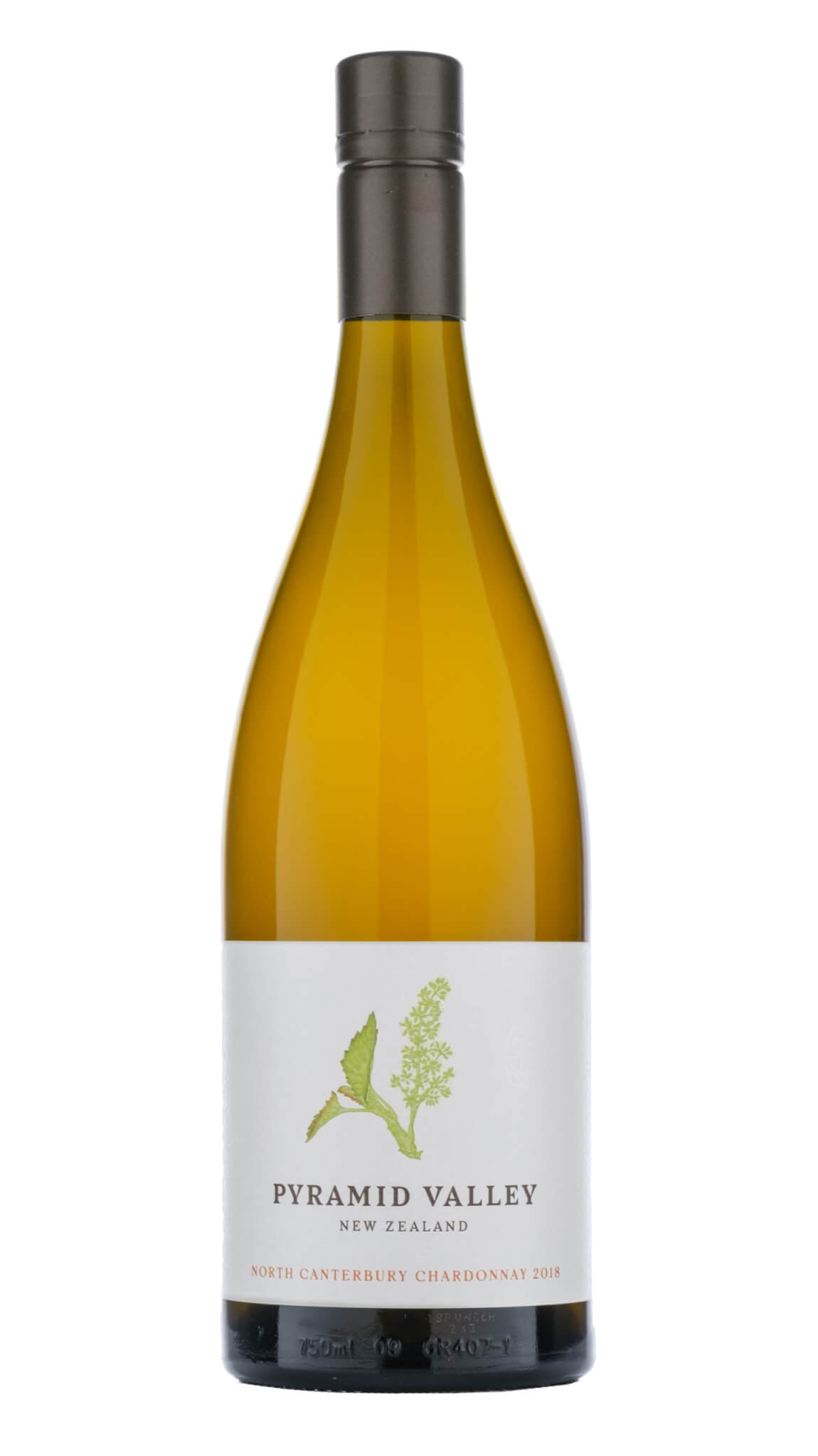
Pyramid Valley 2018 North Canterbury Chardonnay
Concentrated flavors, notably stone fruit, rock melon (I believe called cantaloupe in some parts of the world), and grilled cashews. A supple palate with a lovely creaminess to the texture. Good acidity. Young but finely balanced. Intense and it maintains that intensity on a long finish. Seamless. A really good Chardy and I love it. 95. AUD$50.
Pyramid Valley North Canterbury Pinot Noir 2018: Grower sourced from a blend of four vineyards from the Waipara region and a mix of clones, this might just be my favorite wine of the entire release, if one factors in both quality and value. There are Burgundians offering Premier Cru wines they wish were this good and yet are several times the cost. You won’t find much better Pinot for AUD$50.
Fermented in open-top fermenters with 30 percent whole bunch (I had to read that three times because you just could not pick it, so well is the wine integrated). French barrels for 11 months, 20 percent new. Unfined and unfiltered. A lovely, subtle, low-key, complex Pinot. Truffles, warm earth, red fruits, root vegetables, dry herbs, and oodles of mixed spices. Juicy acidity, very fine silky tannins, balance, and length. What is not to love? Alluring Pinot with 8 to 12 years ahead of it. 96. AUD$50.
Pyramid Valley Central Otago Pinot Noir 2018: From the Manata Estate at Lowburn Ferry (same vineyard providing the fruit for their Home Block Pinot), which was converted to organics in 2018. Close planted – 3,000 vines/hectare. Destemmed, a small amount of whole berry, ten months in French oak, 19 percent new.
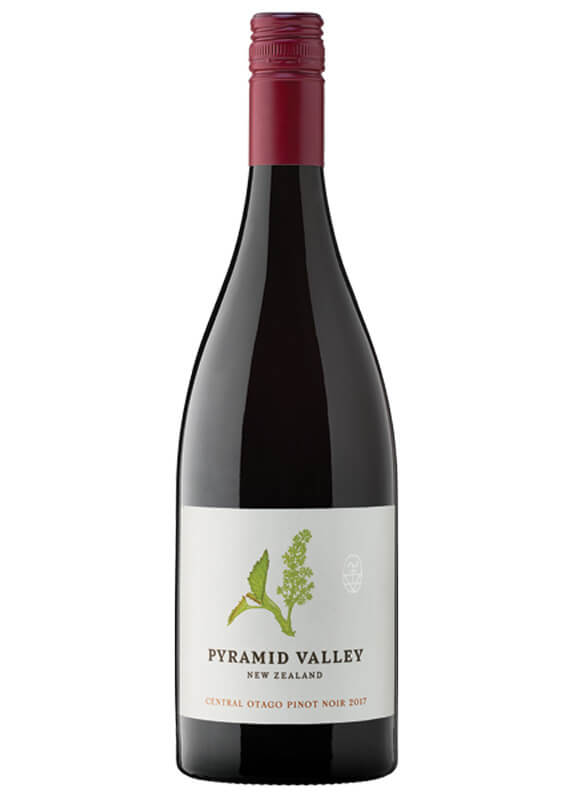
Pyramid Valley Central Otago Pinot Noir 2018
Another fine Pinot, rich and ripe. Flavors boom out like a thumping drum. Cherry flavors and a hint of mushrooms. Some oak. Has some plushness but is not as complex as the North Canterbury wine. More of a crowd pleaser. Slightly fine grainy tannins. Appealing and delicious. 94. AUD$50.
Pyramid Valley Field of Fire Chardonnay 2018: Only 99 six packs of this wine were made. That gives you an idea of the rarity of this cult offering. From a tiny southeast facing block on the Waikari Estate on Pyramid Valley Road, planted in 2000. A biodynamic vineyard, this wine is foot stomped and whole bunch pressed. Wild yeasts, 17 months on lees in barrel, then bottled unfined and unfiltered.
Powerful, nutty and complex. There are summer herbs and tropical and citrus notes. The highlight is the lovely creaminess of the texture. Incredible length, juicy acidity. Many years ahead. A seamless and superb Chardy. 96. AUD$150.
Pyramid Valley Earth Smoke Pinot Noir 2018: Hand-destemmed and partially crushed by foot. Wild yeasts, cuvaison for a lunar cycle (28 days), settled for another, and then transferred to French barrels by gravity. Élevage for 16 months, then bottled unfined and unfiltered. Only 97 six packs made.
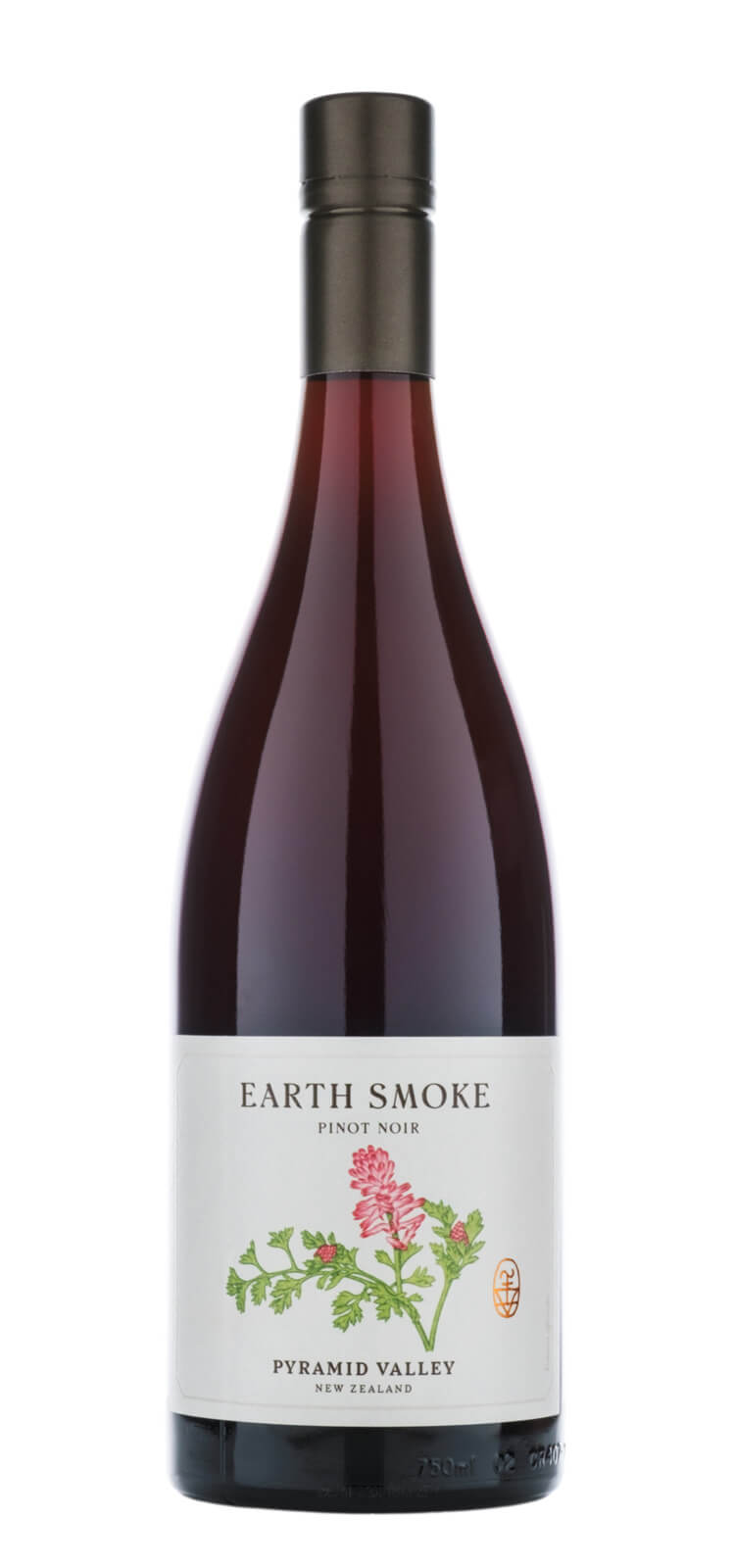
Pyramid Valley Earth Smoke Pinot Noir
A pale but vibrant red with lifted aromatics. Black cherries, truffles, tobacco leaf, old leather. There is weight on the palate but a lightness as well. Moves into the classic forest floor notes. Bright acidity. Seamless, supple, and long. A decade ahead. 97. AUD$150.
Pyramid Valley Lebecca Vineyard Marlborough Riesling 2005: Finally, I went to my own cellar. Sadly, there is very little Pyramid Valley nestled away there but I found an older Riesling. With some trepidation, I gave it a go. I need not have worried. Just gorgeous. A wonderful golden color indicating some serious maturity but not a hint of tiredness or lack of life or condition. Nicely balanced and the sweetness in this wine has come to the fore, but everything is in proportion. Honey, apple pie, peaches, baked fruits, this is a wonderfully rich and delicious wine. Great length.
It was made as an Auslese style and this is evident. Only 8.5 percent alcohol. For me, 95.
For more information, please visit www.pyramidvalley.co.nz.
You may also enjoy:
New Zealand’s Craggy Range Winery And The Revelatory Le Sol Syrah: Tasting Notes Inside
Gimblett Gravels Annual Vintage Selection From Hawke’s Bay, New Zealand: Wine Highlights And Scores
Smith & Sheth Cru: Rich, Exciting Wines From New Zealand With Alluring Aromas
Gimblett Gravels Annual Vintage Selection From Hawke’s Bay, New Zealand: Wine Highlights And Scores
Peter Lehmann’s Masterson Shiraz: The Newest ‘Old’ Star Emerging From The Barossa Valley
Leave a Reply
Want to join the discussion?Feel free to contribute!



A very sad postscript. Around the time that this piece was published, Mike Weersing sadly passed away from illness. I had not heard that at the time – only heard yesterday. Such a very sad loss and sincerest condolences to his family and friends. Anyone whoever met Mike came away impressed by the bloke. Incredibly thoughtful and perceptive, a wonderful winemaker, and just a really nice guy. He will be greatly missed.